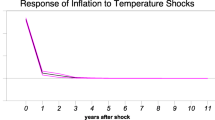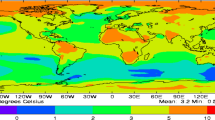Abstract
A growing empirical literature attempts to assess the effect of climate and institutional quality (measured by e.g. economic freedom) on economic growth, both being important fundamental growth conditions. So far, these conditions have been studied apart, even if they from a theoretical point of view are non-exclusive and could both be important. This study investigates their interaction and relative importance, using dynamic panel models. Both global warming and declining institutional quality affect growth adversely. A permanent negative shock of one unit to institutional quality (on a 0–10 scale) is associated with a 10.4% lower long run GDP per capita. In our preferred model, the adverse growth effect of global warming is significant and large compared to the literature, implying a 3.4% drop in global GDP from a 1 °C temperature rise. The effect is quadratic. For 79% of the World the adverse effect of a one-point fall in institutional quality dwarfs the effect of a temperature rise of one degree. Our study suggests that policies to reduce global warming should not be at the expense of policies to enhance institutional quality, which are more important for long time growth.





Similar content being viewed by others
Notes
There has however been some concern with Acemoglu et al. (2001)’s settler mortality data. Albouy (2012) and Fails and Krieckhaus (2010) argue that the causal relationship between economic growth and institutional quality is driven by “Neo-Europe” (i.e. Canada, USA, Australia and New Zealand) and measurement errors in log settler mortality. However, Acemoglu et al. (2012) argued that when one does not exclude more than half of the previous colonies (as Albouy (2012) does), the results from Acemoglu et al. (2001) are robust to measurement errors and the exclusion of “Neo Europe”.
Note that we can test for this restriction empirically in the first stage of two stage least square regression.
It is not possible to test for zero correlation between log settler mortality and the error terms in the empirical model.
Dell et al. (2014) argued that there are some specific case studies, which provide information on the long effects of weather variables, but this is not what is done in the panel growth regressions.
Dell et al. (2012) show that their estimates of the effects of short-run weather fluctuations are in line with the medium effects of weather fluctuations, but still they do not provide estimates of the long-run economic effects of permanent shocks to the weather variables.
An informal check of the stability of the estimated models could be to plot of the average fitted growth rate over time; in such a figure the fitted growth rates should not be trending.
Note, that this index is constant in the years 1970–1974, 1975–1979, 1980–1984,1985–1989,1990–1994, 1995–1999.
In the present study, indicators from both institutions have been tried as a substitute for the EFI; the with-country variation, however, is too small.
Dell et al. (2012) similarly does not include data beyond 2003.
The reason why we use a random effect model for estimation is that in model 3 we include a time invariant variable to the regressions; hence we cannot apply the fixed effect estimator to these models.
Dell et al. (2012) provide the Poor Dummy in their dataset. They defined a country as being poor if it has PPP GDP per capita, which is below median GDP per capita in the first year that country enters the data. The Poor Dummy is missing for Myanmar in the Dell et al. (2012) data, but in our regressions, we treat Myanmar as a poor country.
This implies that we would exclude all non-former colonies.
An alternative to using the fixed effect estimator is to use the Arrelano-Bond estimator (Arellano and Bond 1991). However, Monte-Carlo studies conducted by Hauck Jr and Waczeirg (2004) show that the Arellano-Bond estimator inflates the rates of convergence much more than the fixed estimator. In our models, the Arrelano-Bond estimator produces estimated rates of convergence around 20 per cent per year, which is a much faster estimated rate of convergence than any of the with-in estimators, and hence the with-in estimator is our preferred estimator. The results using the Arrelano-Bond estimator are available upon request.
We have interacted all the covariates with the Poor Dummy, but the interaction terms are all insignificant, expect for temperature. The results are available upon request.
We note that Dell et al. (2012) use the growth rate of GDP per capita as the dependent variable, and hence the Poor Dummy is not constructed based on their dependent variables. Therefore, Dell et al. (2012)’s finding that the economic effects of temperature are significant in poor countries is less likely to hold per construction than in our setting.
We have interacted all of covariates with the former colony dummy, but none of the interactions are significant on a 5% significance level.
Burke et al. (2015) also interacted temperature and temperature squared with a Poor Dummy, and they found that the marginal effects of temperature do not differ between rich and poor countries given that the temperature is the same for the two countries. Hence, in model 11 we do not interact any of our variables with a Poor Dummy.
We have squared all the covariates, but it is only squared temperature, which is significant.
The Paris Accord aim is to limit the post-industrialization temperature rise to 1½–2 °C.
Note, that the estimated semi-elasticities are the semi-elasticities for GDP per capita and not GDP. However, if we assume that none of the variables of interest affects the population size, the semi-elasticity for GDP for some variable is the same as for GDP per capita.
The reported effect is from a three degrees Celsius temperature rise, compared to pre-Industrial levels.
Note that we plot the” losses” from increasing temperature, so the effects are negative for cold countries (that benefit from increasing temperature) and positive for hot countries.
We do not use World Bank data for log chained PPP GDP per capita as a robustness check, since our panel will be quite short (the series starts at 1990) and hence the Nickell bias will be substantial. Instead we note that both Burke et al. (2015) and Dell et al. (2012), provide robustness checks which suggest that their results are not sensitive to the choice of national account data from Word Bank or Penn-World table. In addition, we do not consider a balanced panel, since we would have to start the panel at around 1990, following the fall of the Berlin Wall and the breakdown of the Soviet Union; hence we would once again have problems with a short panel and a substantial Nickell-bias.
For example, it could be the case if foreign aid helps incompetent and corrupt leaders to stay in power in the developing countries. In addition, foreign aid might release some of the pressure for improving the institutional quality in these countries. Finally, the foreign aid rises the concerns of rent seeking, in the sense that the leaders of the developing countries could use the foreign aid for the projects, which are profitable for themselves, but does not increase wealth for the country.
References
Acemoglu D, Johnson S, Robinson JA (2001) The colonial origins of comparative development: an empirical investigation. Am Econ Rev 91(5):1369–1401. https://doi.org/10.1257/aer.91.5.1369
Acemoglu D, Johnson S, Robinson J (2004) Institutions as the fundamental cause of long-run growth. DOCUMENTOS CEDE, September. https://ideas.repec.org/p/col/000089/002889.html. Accessed 17 Jan 2019
Acemoglu D, Johnson S, Robinson JA (2012) The colonial origins of comparative development: an empirical investigation: reply. Am Econ Rev 102(6):3077–3110. https://doi.org/10.1257/aer.102.6.3077
Albouy DY (2012) The colonial origins of comparative development: an empirical investigation: comment. Am Econ Rev 102(6):3059–3076. https://doi.org/10.1257/aer.102.6.3059
Arellano M, Bond S (1991) Some tests of specification for panel data: monte carlo evidence and an application to employment equations. Rev Econ Stud 58(2):277. https://doi.org/10.2307/2297968
Arvin B, Lew B (2015) Handbook on the economics of foreign aid. Edward Elgar Publishing, Cheltenham. https://doi.org/10.4337/9781783474592
Barro RJ (1989) Economic growth in a cross section of countries. NBER Working Papers, September. https://ideas.repec.org/p/nbr/nberwo/3120.html. Accessed 17 Jan 2019
Barro RJ (2015) Convergence and modernisation. Econ J 125(585):911–942. https://doi.org/10.1111/ecoj.12247
Blomberg (2018) Climate aid for poor countries reached $70 Billion in 2016, 2018. https://www.bloomberg.com/news/articles/2018-11-23/climate-aid-for-poor-countries-reached-70-billion-in-2016. Accessed 23 Feb 2019
Brennan G, Buchanan JM (2008) The reason of rules. Cambridge Books. https://ideas.repec.org/b/cup/cbooks/9780521070904.html. Accessed 11 Sept 2017
Burke M, Hsiang SM, Miguel E (2015) Global non-linear effect of temperature on economic production. Nature 527(7577):235–239. https://doi.org/10.1038/nature15725
Daron A, Naidu S, Restrepo P, Robinson JA (2019) Democracy does cause growth. J Polit Econ. https://doi.org/10.1086/700936
Deaton A (2013) The great escape: health, wealth, and the origins of inequality. Princeton University Press, Princeton. https://doi.org/10.2307/j.ctt3fgxbm
Dell M, Jones BF, Olken BA (2012) Temperature shocks and economic growth: evidence from the last half century. Am Econ J Macroecon 4(3):66–95. https://doi.org/10.1257/mac.4.3.66
Dell M, Jones BF, Olken BA (2014) What do we learn from the weather? The new climate-economy literature. J Econ Liter 52(3):740–798
Fails MD, Krieckhaus J (2010) Colonialism, property rights and the modern world income distribution. Br J Polit Sci 40(03):487–508. https://doi.org/10.1017/S0007123410000141
Feenstra RC, Inklaar R, Timmer MP (2015) The next generation of the Penn world table. Am Econ Rev 105(10):3150–3182. https://doi.org/10.1257/aer.20130954
Golosov M, Hassler J, Krusell P, Tsyvinski A (2014) Optimal taxes on fossil fuel in general equilibrium. Econometrica 82(1):41–88. https://doi.org/10.3982/ECTA10217
Gwartney J, Lawson R, Hall J (2017) Economic freedom of the world: 2017 Annual Report. http://www.deslibris.ca/ID/10092608. Accessed 20 Nov 2018
Hauck Jr WR, Waczeirg R (2004) A monte carlo study of growth regression. Working Paper
Hayek FA (1981) Law, legislation and liberty, vol 3. University of Chicago Press Economics Books. https://ideas.repec.org/b/ucp/bkecon/9780226320908.html. Accessed 11 Sept 2017
Hurwicz L (1996) Institutions as families of game forms. Jpn Econ Rev 47(2):113–132
Klima-, Energi- og Forsyningsministeriet (2019) Aftale Om Klimalov Af 6. December 2019. https://kefm.dk/media/12965/aftale-om-klimalov-af-6-december-2019.pdf. Accessed 12 June 2019
Levin A, Lin C-F, Chu C-SJ (2002) Unit root tests in panel data: asymptotic and finite-sample properties. J Econometr 108(1):1–24. https://doi.org/10.1016/S0304-4076(01)00098-7
Maddala GS, Kim I-M (1998) Unit Roots, cointegration, and structural change. Themes in modern econometrics. Cambridge [England]. Cambridge University Press, New York
Nickell S (1981) Biases in dynamic models with fixed effects. Econometrica 49(6):1417. https://doi.org/10.2307/1911408
Nordhaus W (2013) Integrated economic and climate modeling. In: Handbook of computable general equilibrium modeling, 1069–1131. Elsevier. https://econpapers.repec.org/bookchap/eeehacchp/v_3a1_3ay_3a2013_3ai_3ac_3ap_3a1069-1131.htm. Accessed 15 Dec 2018
Nordhaus W, Moffat A (2017) A survey of global impacts of climate change: replication, survey methods, and a statistical analysis, vol w23646. National Bureau of Economic Research, Cambridge. https://doi.org/10.3386/w23646
North DC (1990) Institutions, institutional change and economic performance. Cambridge University Press. https://books.google.dk/books?id=oFnWbTqgNPYC. Accessed 10 Sept 2018
OECD (2018) Effective carbon rates 2018: pricing carbon emissions through taxes and emissions trading. OECD. https://doi.org/10.1787/9789264305304-en
Olson M (2008) The rise and decline of nations: economic growth, stagflation, and social rigidities. Industria y Gestion Empresarial. Yale University Press. https://books.google.dk/books?id=GEkSusqBH84C. Accessed 11 Sept 2017
Rodrik D, Subramanian A, Trebbi F (2004) Institutions rule: the primacy of institutions over geography and integration in economic development. J Econ Growth 9(2):131–165. https://doi.org/10.1023/B:JOEG.0000031425.72248.85
Smith A (1776) An inquiry into the nature and causes of the wealth of nations. http://www.gutenberg.org/ebooks/3300. Accessed 11 Sept 2017
Stern N (2007) Stern review: the economics of climate change. http://mudancasclimaticas.cptec.inpe.br/~rmclima/pdfs/destaques/sternreview_report_complete.pdf. Accessed 20 Feb 2018
Wall Street Journal (2019) ‘Economists’ statement on carbon dividends. Bipartisan agreement on how to combat climate change. 2019. https://www.wsj.com/articles/economists-statement-on-carbon-dividends-11547682910. Accessed 10 Sept 2019
Williamson J (2004) The strange history of the washington consensus. J Post Keynesian Econ 27(2):195–206
Zivin JS, Graff SH, Neidell M (2015) Temperature and human capital in the short- and long-run, vol w21157. National Bureau of Economic Research, Cambridge. https://doi.org/10.3386/w21157
Author information
Authors and Affiliations
Corresponding author
Additional information
Publisher's Note
Springer Nature remains neutral with regard to jurisdictional claims in published maps and institutional affiliations.
The data and replication codes are available at http://www.cepos.dk/documentation.
About this article
Cite this article
Brøns-Petersen, O., Gjedsted, S.H. Climate change and institutional change: what is the relative importance for economic performance?. Environ Econ Policy Stud 23, 333–360 (2021). https://doi.org/10.1007/s10018-020-00290-7
Received:
Accepted:
Published:
Issue Date:
DOI: https://doi.org/10.1007/s10018-020-00290-7




